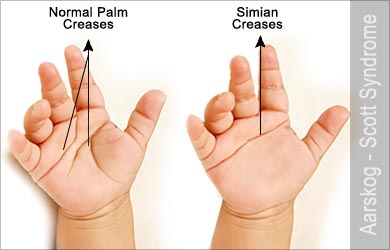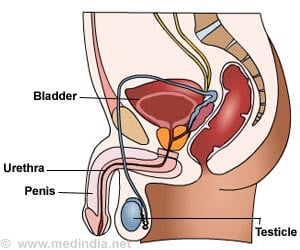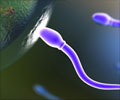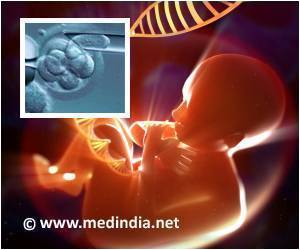- Aarskog D (1970). "A familial syndrome of short stature associated with facial dysplasia and genital anomalies". J. Pediatr. 77 (5): 856–61
- Scott CI (1971). "Unusual facies, joint hypermobility, genital anomaly and short stature: a new dysmorphic syndrome". Birth Defects Orig. Artic. Ser. 7 (6): 240–6.
- Orrico A, Galli L, Buoni S, Hayek G, Luchetti A, Lorenzini S, Zappella M, Pomponi MG, Sorrentino V. Attention-deficit/hyperactivity disorder (ADHD) and variable clinical expression of Aarskog-Scott syndrome due to a novel FGD1 gene mutation (R408Q). Am J Med Genet A. 2005 May 15;135(1):99-102.
- A.D.A.M, U.S. National Library of Medicine, Wikepedia
About
Aarskog Syndrome is a genetic disorder that mainly affects males. It affects the development of many parts of the body.
Aarskog–Scott syndrome is an inherited disease that affects the development of many parts of the body. A person's height, muscles, skeleton, genitals, and appearance of the face are affected by this genetic disease.

Aarskog–Scott syndrome is also called Aarskog syndrome, faciodigitogenital syndrome, shawl scrotum syndrome and faciogenital dysplasia. The syndrome is named after Dagfinn Aarskog and Charles I. Scott, Jr. who independently described the condition in 1970 and 1971, respectively.
Genetic testing for specific mutations may help in the diagnosis of the condition. Treatment targets the correction of various abnormalities in the body. Genetic counselling is indicated for individuals or families who carry genes for Aarskog–Scott syndrome.
What is the Cause of Aarskog-Scott Syndrome?
Mutations in the "faciogenital dysplasia" (FGD1) gene are responsible for Aarskog–Scott syndrome. The syndrome is rare.
Genetics
Aarskog–Scott syndrome is a genetic disorder that mainly affects males. Females may have a milder form of the disease. Changes (mutations) in the "faciogenital dysplasia" (FGD1) gene are responsible for the syndrome. The disease is transmitted in an X-linked recessive manner. This is a hereditary pattern in which a recessive gene on the X chromosome results in disease manifestations in male offspring. A trait is said to be recessive when it becomes clinically apparent only when an individual carries two copies of its gene (unlike a dominant trait which get expressed even if a single copy of the gene is present). The female offspring has 2 X chromosomes, out of which one is often normal; this female will only be a carrier, i.e. she does not clinically have the disease but her sons will have a 50% risk of being affected.
Incidence and Prevalence
The syndrome is rare; the exact prevalence is unknown. Mildly affected people are often not diagnosed.
Risk factors
Aarskog–Scott syndrome is an inherited disorder that runs in families. Specific risk factors have not been listed.
What are the Symptoms and Signs of Aarskog-Scott Syndrome?
Height, muscles, skeleton, genitals, and appearance of the face are affected by Aarskog–Scott syndrome.
Aarskog–Scott syndrome affects the normal development of many parts of the body. People with the condition often have:
- Distinctive facial features:
- Rounded face
- Widely spaced eyes (hypertelorism)
- Small nose
- A long area between the nose and mouth (philtrum)
- A widow's peak hairline (a V-shaped point in the hairline in the centre of the forehead is termed as widow’s peak)
- Delayed tooth eruption
- Mild-to-moderate height reduction by 1-3 years of age; they may catch up with a normal growth by puberty
- Slight-to-moderate mental deficiency; hyperactivity and attention deficit may occur
- Short neck; sides of the neck may be webbed
- Sunken chest (pectus excavatum)
- Changes in hands and feet:
- Short fingers and toes (brachydactyly); incurving of fifth finger(clinodactyly) broad thumbs and big toes; webbing between fingers and toes
- Protruding belly button
- Shawl scrotum (scrotum surrounds the penis); testes may fail to descend (cryptorchidism)
- Inguinal hernias (hernias in the groin region) where abdominal cavity contents may protrude into the hernia
Aarskog–Scott Syndrome Diagnosis, Treatment and Support Groups
Genetic test for FGD1 gene may help in diagnosing Aarskog syndrome. Treatment targets the correction of some of the anomalies.
Diagnosis
Aarskog–Scott syndrome may be diagnosed by genetic testing for mutations in the "faciogenital dysplasia" (FGD1) gene. Overlapping features with a condition called fetal alcohol syndrome may result in clinical misdiagnosis.
Treatment
Treatment targets the correction of some of the anomalies. Surgery may be required in some cases. Some of the abnormal facial features are corrected with orthodontic treatment. Trials of growth hormone have shown promising results in treating short stature (height).
Support Groups
The MAGIC Foundation for Children's Growth is a support group for Aarskog syndrome. More information is available at www.magicfoundation.org.
What is the Prognosis of Aarskog–Scott Syndrome?
Some children with Aarskog–Scott syndrome are born with serious heart defects. Some males suffer reduced fertility.
Prognosis
People with Aarskog–Scott syndrome may have a mild degree of mental slowness. Affected children usually have good social skills. Reduced fertility is a problem faced by some of the affected males.
Complications
- Changes in the brain
- Seizures
- Testes may fail to descend (cryptorchidism)
- Poor alignment of teeth
- Some children are born with serious heart defects. Cleft lip with or without an opening in the roof of the mouth (cleft palate) is also found in some.







